Try this traditional Turkish delights with pistachio & orange recipe to transport yourself to Anatolia! It's hard to go wrong with this classic flavor combination—especially if you've tried rose lokum and weren't a fan before. Authentically vegan & gluten-free.
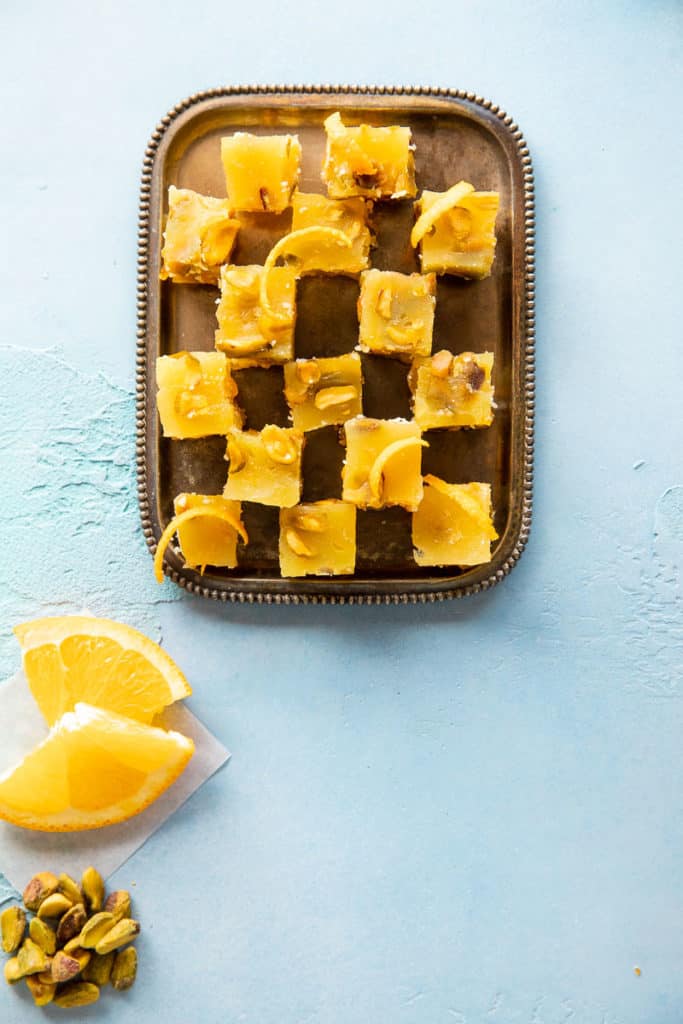
My three favorite Turkish delight varieties are:
- Classic rose
- Orange & pistachio
- Double-roasted walnut
Although every single one of them is quite popular in Turkey, out of the three, orange & pistachio is the safest flavor combination to experiment with. Especially if lokum is new to your palate.
How to Make Traditional Turkish Delights with Pistachio & Orange
Makes 48 ~1-inch cubes, approximately 12 servings.
Ingredients
For Lokum:
- 350g (scant 2 cups) white sugar (See Note 1)
- 175ml (¾ cup) water (for syrup)
- 1.8g (¼ teaspoon) citric acid (See Note 2)
- 70g (½ cup + 1 tablespoon) cornstarch
- 50ml (¼ cup) orange juice (See Note 3)
- 450ml (2 cups) water (for cornstarch)
- 1 tablespoon orange peel
- 1 cup pistachio meat
- optional: 3 drops of red & yellow food colorings each
For Cutting & Dredging:
- 1 cup very finely shredded coconut
Notes on the Ingredients:
- Make sure the sugar is the regular white variety as the less processed yellow-looking ones will make it difficult to judge the final steps of this recipe where we partially depend on the color.
- You may substitute citric acid with either the same volume of cream of tartar, or quadruple the volume of lemon juice. 1 tablespoon of lemon juice roughly equals ¼ teaspoon of citric acid. However, unlike citric acid or cream of tartar, lemon juice will impart some flavor to your Turkish delight.
- If you have orange extract, I'd highly recommend using it to enhance the flavor. You may completely replace the orange juice in the original recipe quantities by adding 1.5 teaspoon of extract. Feel free to experiment with other citrus flavors such as lemon, mandarin, or even yuzu!
Instructions for Making the Traditional Turkish Delights with Pistachio & Orange Recipe
1. Add the sugar, citric acid, and water into a heavy-bottomed pan and mix until the sugar dissolves.
2. Bring the mixture to a boil on high heat, then lower the heat down to a simmer and wait until the syrup reaches 250°F (hard ball stage, See Note 1). Make sure to adjust this temperature for your kitchen's altitude and observe the pan closely—a clipped candy thermometer will give the most reliable results. This should take 15-30 minutes depending on your stove's heat output.
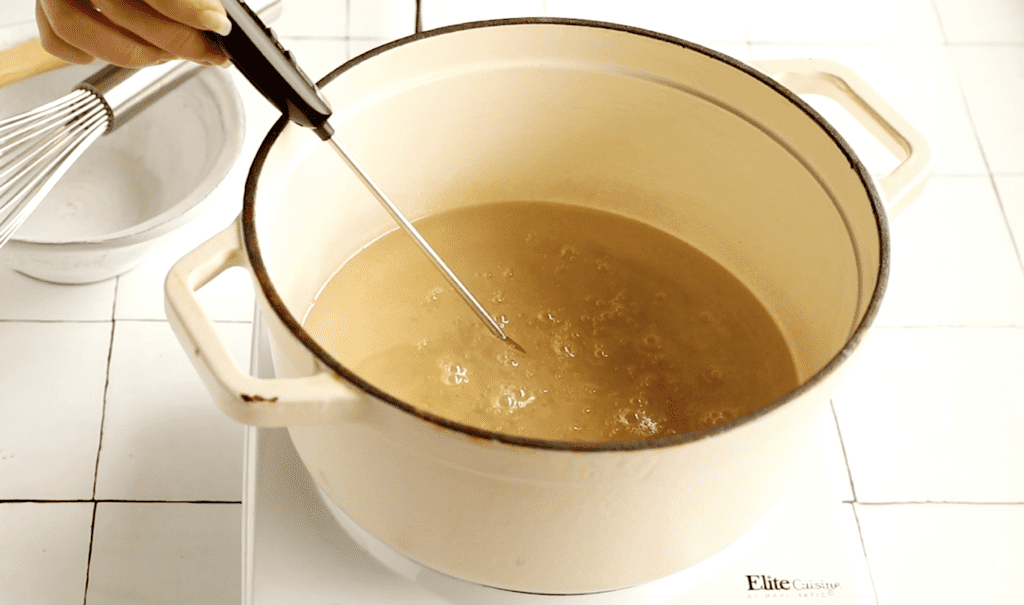
3. Meanwhile, prepare the cornstarch mixture by adding cornstarch, water, and orange juice into a jar. Close the lid and shake vigorously until there are no visible lumps of starch. Alternatively, thoroughly mix in a separate bowl.
4. Once the syrup reaches 250°F, turn off the heat and gradually add the just-shaken cornstarch mix into the pan, whisking continuously.
5. When all the cornstarch is incorporated, turn the heat on to medium-low and continue whisking until gelation. It should only take a few minutes for the mixture to thicken.
6. Once it’s thickened, put the heat on low to simmer, and make sure to mix it (See Note 2) about every 7-8 minutes to prevent it from sticking to the bottom. Be careful as the thickened mixture may splatter. Continue this process for 1-2 hours.
7. Prepare a mold by spreading a small amount of neutral oil into a container (See Notes 3 & 4).
8. To judge whether the mixture is done cooking, look for a relatively thick—but not gloopy—texture and a medium-dark shade of warm amber. Around the 1 ½-hour mark, the mixture is usually very close to being done. This timeframe will depend on a variety of factors such as pan width, changing the ingredient amounts to make more/less lokum, and the stove's heat output. It can go up to 2 hours+.
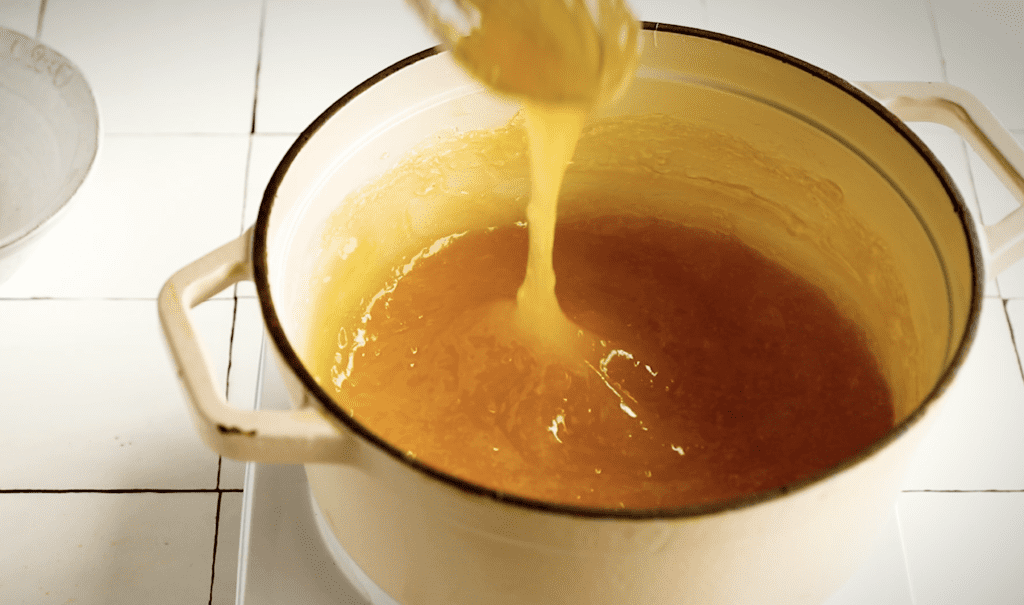
9. When the Turkish delight is done cooking, turn off the heat, and mix in the food coloring (optional). Add in the orange zest and pistachio meat, mix, pour into the container, and set aside at room temperature for at least 5 hours—preferably a full day especially if you’re somewhere hot and humid.
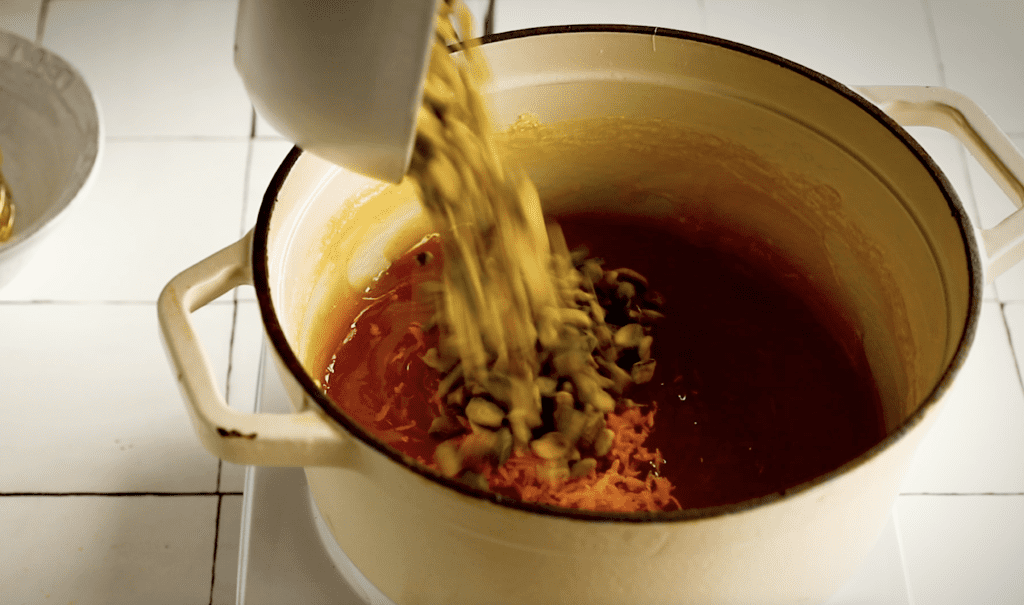
10. The next day, sprinkle shredded coconut into the container then cut out a strip from the edge so that you can remove the entire slab. Cut into cubes, then dredge them in coconut.
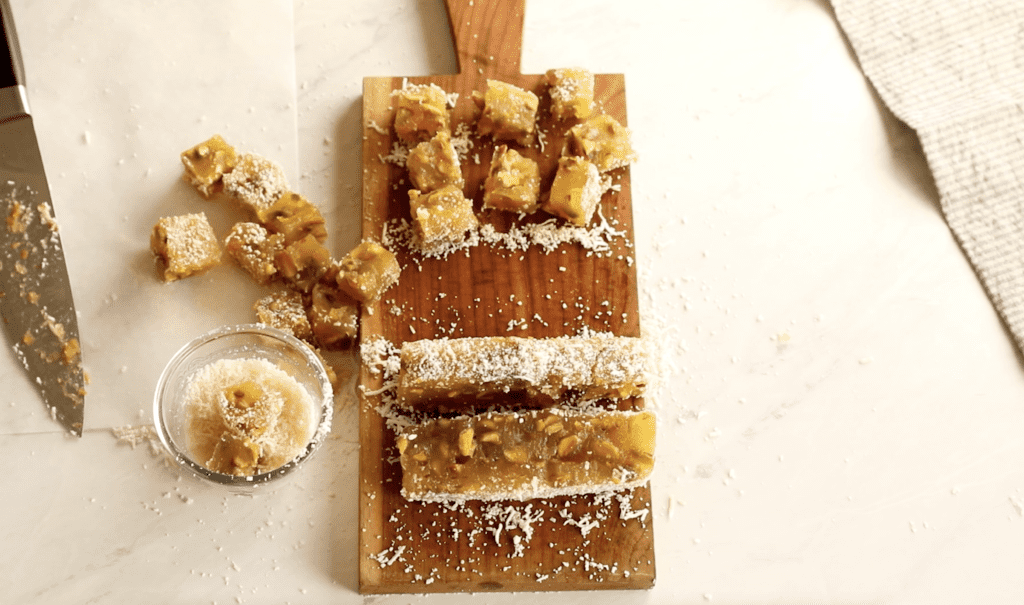
12. Enjoy alongside Turkish coffee and water as is common in Turkey.
Important Notes for the Turkish Delight Recipe
1. This is the most crucial part of the recipe. I can't recommend a candy thermometer enough, but in case you're set on making do without, use the cold water test. We’re looking for the hard ball stage: meaning that once you pour a small amount of the simmering syrup into cold water—it should form a hard but malleable ball between your fingers. You need to be very quick in doing this, because the heating rate accelerates very rapidly after about 220°F because of the high sugar concentration in the syrup. Anywhere up to 260°F is okay, but go above this and you will get hard candy without realizing after 2+ hours of cooking.
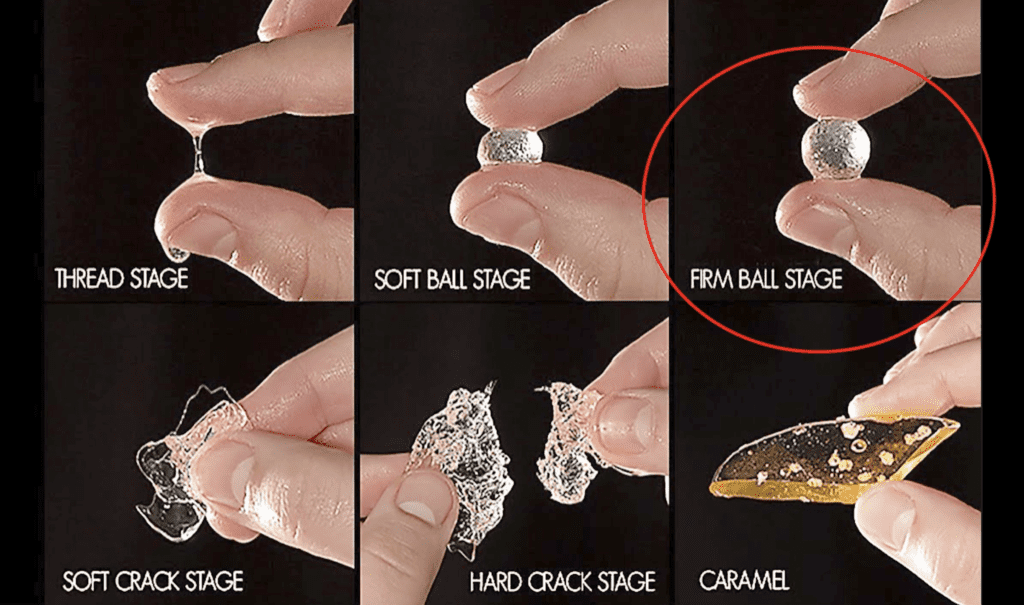
If you are using a candy thermometer, testing it on boiling water to ensure it works correctly is not a bad idea. Additionally, make sure to factor in the altitude of your kitchen. For instance, if you are making this in Denver, CO, you'll be looking for 240°F instead 250°F. Each 500 ft increase in elevation causes water to boil at 1°F lower.
2. Make sure to be gentle while stirring after gelation. Any forceful whisking may cause the starch chains to disintegrate, causing a thinned-out consistency. However, a little thinning after the initial thickening is expected whenever cornstarch gelates.
3. A 5in x 7in glass container used for the original recipe yields 48 ~1-inch cubes of Turkish delight in two layers. However, feel free to use whatever size container is available to you.
4. Some prefer to line the container with plastic wrap instead of using oil. While this will help in removing the slab of lokum, it also creates numerous creases on the surface. Therefore I don't prefer it.
Storage for the Traditional Turkish Delights with Pistachio & Orange: The Best Way to Preserve Lokum
Turkish delight stores exceptionally well. I find that the best time to enjoy lokum is two days after preparing them. This gives it enough time for the delicate chewiness to develop. After the initial drying out, I recommend storing them in the refrigerator covered with all the leftover shredded coconut from dredging. Prior to serving, make sure to bring Turkish delights back to room temperature.
A few caveats regarding storage:
- If everything went right, the finished delights should have a quite low proportion of water, 15% at a maximum. These delights will keep for many months at room temperature (dry environment away from sunlight) or in the refrigerator. I've even had year-old Turkish delight that got lost behind miso paste in our refrigerator before; it was perfectly fine to eat but wasn't as soft. All to say, expect the sensory qualities of lokum to deteriorate after a few months.
- However, in case your lokum turned out more watery than this (likely due to not heating the syrup to hard ball, whisking the mixture too vigorously after gelation, or taking it off the heat too quickly)—they will need to be consumed quickly, ideally within a week. Store them in the refrigerator covered with all the leftover coconut from dredging, in an airtight container.
- If your Turkish delight has nuts, like this one does, make sure to store them in the refrigerator.
Other Turkish Delights
If you'd like to try other flavors in addition to Turkish delights with pistachio & orange, try the authentic rose lokum or the double-roasted walnut one. All of them are delicious and widely consumed in Turkey.
In case you don't want to bother with a recipe at all—try purchasing premade ones online. My favorite lokum comes from small local shops, but you can't go wrong with a variety pack by this established company whose founder invented Turkish delight: Haci Bekir.
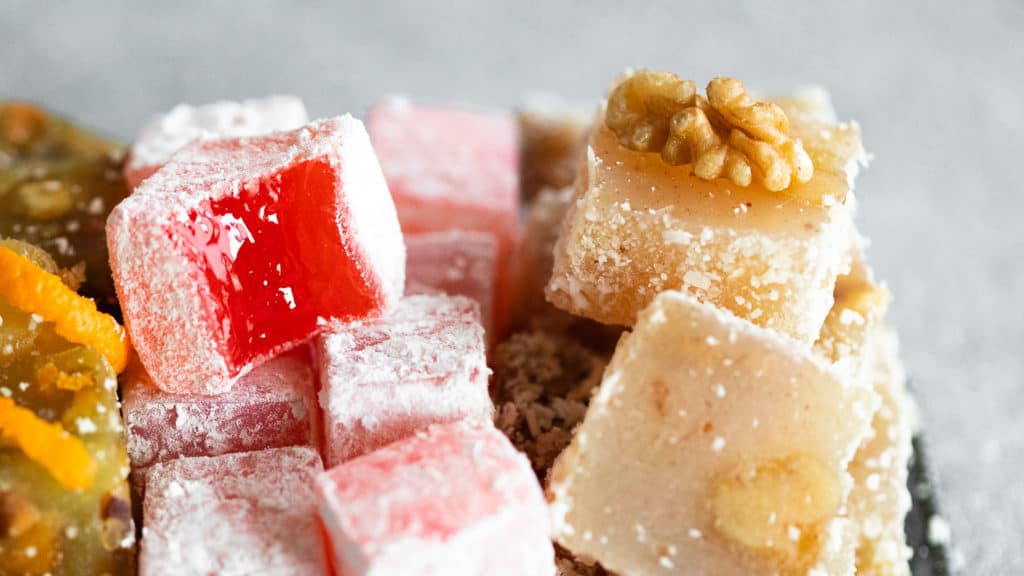
Looking for other Turkish dessert recipes? Try:
- Kabak Tatlısı: Traditional Turkish Pumpkin Dessert
- Zerde: Turmeric Rice Pudding from the Ottoman Palace
- Easy Baklava with Phyllo
- Pestil: Homemade Fruit Rollups with Nuts
Don’t forget to let me know in the comments if you make these Turkish delights with pistachio & orange. I make sure to respond to each one. Afiyet olsun (bon appétit)!
You can also save it for later on Pinterest, and keep in touch with me on YouTube, Instagram, or by sending an email.
Print📖 Recipe

Traditional Turkish Delights with Pistachio & Orange
- Total Time: 2 hours 40 minutes
- Yield: 48 ~1-inch cubes 1x
- Diet: Vegan
Description
Try this traditional Turkish delights with pistachio & orange recipe to transport yourself to Anatolia! It's hard to go wrong with this classic flavor combination—especially if you've tried rose lokum and weren't a fan before. Authentically vegan & gluten-free.
Ingredients
For Lokum:
- 350g (scant 2 cups) white sugar (See Note 1)
- 175ml (¾ cup) water (for syrup)
- 1.8g (¼ teaspoon) citric acid (See Note 2)
- 70g (½ cup + 1 tablespoon) cornstarch
- 50ml (¼ cup) orange juice (See Note 3)
- 450ml (2 cups) water (for cornstarch)
- 1 tablespoon orange peel
- 1 cup pistachio meat
- optional: 3 drops of red & yellow food colorings each
For Cutting & Dredging:
- 1 cup very finely shredded coconut
Notes on the Ingredients:
- Make sure the sugar is the regular white variety as the less processed yellow-looking ones will make it difficult to judge the final steps of this recipe where we partially depend on the color.
- You may substitute citric acid with either the same volume of cream of tartar, or quadruple the volume of lemon juice. 1 tablespoon of lemon juice roughly equals ¼ teaspoon of citric acid. However, unlike citric acid or cream of tartar, lemon juice will impart some flavor to your Turkish delight.
- If you have orange extract, I'd highly recommend using it to enhance the flavor. You may completely replace the orange juice in the original recipe quantities by adding 1.5 teaspoon of extract. Feel free to experiment with other citrus flavors such as lemon, mandarin, or even yuzu!
Instructions
1. Add the sugar, citric acid, and water into a heavy-bottomed pan and mix until the sugar dissolves.
2. Bring the mixture to a boil on high heat, then lower the heat down to a simmer and wait until the syrup reaches 250°F (hard ball stage, See Note 1). Make sure to adjust this temperature for your kitchen's altitude and observe the pan closely—a clipped candy thermometer will give the most reliable results. This should take 15-30 minutes depending on your stove's heat output.

3. Meanwhile, prepare the cornstarch mixture by adding cornstarch, water, and orange juice into a jar. Close the lid and shake vigorously until there are no visible lumps of starch. Alternatively, thoroughly mix in a separate bowl.
4. Once the syrup reaches 250°F, turn off the heat and gradually add the just-shaken cornstarch mix into the pan, whisking continuously.
5. When all the cornstarch is incorporated, turn the heat on to medium-low and continue whisking until gelation. It should only take a few minutes for the mixture to thicken.
6. Once it’s thickened, put the heat on low to simmer, and make sure to mix it (See Note 2) about every 7-8 minutes to prevent it from sticking to the bottom. Be careful as the thickened mixture may splatter. Continue this process for 1-2 hours.
7. Prepare a mold by spreading a small amount of neutral oil into a container (See Notes 3 & 4).
8. To judge whether the mixture is done cooking, look for a relatively thick—but not gloopy—texture and a medium-dark shade of warm amber. Around the 1 ½-hour mark, the mixture is usually very close to being done. This timeframe will depend on a variety of factors such as pan width, changing the ingredient amounts to make more/less lokum, and the stove's heat output. It can go up to 2 hours+.

9. When the Turkish delight is done cooking, turn off the heat, and mix in the food coloring (optional). Add in the orange zest and pistachio meat, mix, pour into the container, and set aside at room temperature for at least 5 hours—preferably a full day especially if you’re somewhere hot and humid.

10. The next day, sprinkle shredded coconut into the container then cut out a strip from the edge so that you can remove the entire slab. Cut into cubes, then dredge them in coconut.

12. Enjoy alongside Turkish coffee and water as is common in Turkey.
Notes
1. This is the most crucial part of the recipe. I can't recommend a candy thermometer enough, but in case you're set on making do without, use the cold water test. We’re looking for the hard ball stage: meaning that once you pour a small amount of the simmering syrup into cold water—it should form a hard but malleable ball between your fingers. You need to be very quick in doing this, because the heating rate accelerates very rapidly after about 220°F because of the high sugar concentration in the syrup. Anywhere up to 260°F is okay, but go above this and you will get hard candy without realizing after 2+ hours of cooking.

If you are using a candy thermometer, testing it on boiling water to ensure it works correctly is not a bad idea. Additionally, make sure to factor in the altitude of your kitchen. For instance, if you are making this in Denver, CO, you'll be looking for 240°F instead 250°F. Each 500 ft increase in elevation causes water to boil at 1°F lower.
2. Make sure to be gentle while stirring after gelation. Any forceful whisking may cause the starch chains to disintegrate, causing a thinned-out consistency. However, a little thinning after the initial thickening is expected whenever cornstarch gelates.
3. A 5in x 7in glass container used for the original recipe yields 48 ~1-inch cubes of Turkish delight in two layers. However, feel free to use whatever size container is available to you.
4. Some prefer to line the container with plastic wrap instead of using oil. While this will help in removing the slab of lokum, it also creates numerous creases on the surface. Therefore I don't prefer it.
5. Store Turkish delights in the refrigerator covered with all the leftover cornstarch & powdered sugar mix from dredging. Prior to serving, make sure to bring Turkish delights back to room temperature. Consume within two weeks for best results.
- Prep Time: 10 minutes
- Cook Time: 2 hours 30 minutes
- Category: Dessert
- Method: Cook
- Cuisine: Turkish






Julia
Great !!! Thank You for sharing 🌺
Gönül
Happy you've enjoyed it! 🙂